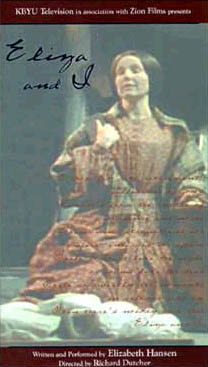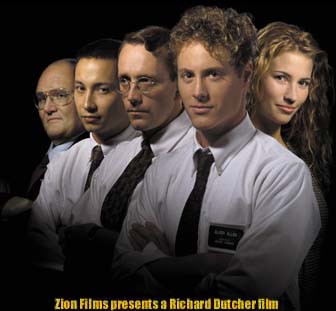




|

|

|
While the content of his Dutcher's films has often triggered wide-spread controversy, both among Latter-day Saints and the general public, his filmmaking skills have received almost universal acclaim. It is not hyperbole to state that Dutcher single-handedly launched an entire new, exciting film genre. His impact on Mormon art and culture is already considered incalculable.
With the unexpected success of "God's Army" in 2000, it seemed to some observers that the film's creator had come from nowhere. But the truth is, Dutcher had already studied and worked for years to perfect his craft. As a student he was focused on acting and the study of film and theater. Money was often in short supply, and at times he lived in his car.
Dutcher's first complete film project was the ultra-low budget student film "Brother John," cost $3,500 to make, less than one-fourth the amount that was spent on similar projects by other students. Despite the film's lower cost, it won BYU's top student film honor: "Producer's Award." In 1988 Dutcher graduated from Brigham Young University with a bachelor's degree in film.
From 1994 to 1996 Dutcher poured everything he had into making his first feature-length film, the romantic comedy "Girl Crazy." This was a commercial quality film, yet the total cost for budget and marketing was $56,000. The film features Dutcher in the starring role as a carefree bachelor who falls in love with a woman and decides to burn his little black book so he can settle down with with her. But he must first convince the love of his life that he is serious about ending his womanizing ways. The cast also included Linda Bon, Tim Hansen, Lisa Manulkin, and Kiki Margiotta.
Although "Girl Crazy" was never distributed theatrically, Dutcher did sell the picture to HBO, and was able to recoup his expenses. He later said that although the script was fluff, making the film was an invaluable experience for him, giving him hands-on feature film experience he had not gotten in film school.
In 1997 Dutcher directed "Eliza and I," a play-like film adapted from the play by BYU professor/actress/playwright Elizabeth J. Hansen. "Eliza and I." In this critically acclaimed production Hansen portrays Eliza R. Snow, who was wife to both Brigham Young and Joseph Smith. "Eliza and I" was shown on public television and is now widely available on video. Dutcher made the "Eliza and I" as a joint venture between KBYU and his fledgling production company "Zion Films" for a cost of $75,000.
It was while working in Hollywood that Dutcher grew frustrated at the seeming incompatability between being working on commercial movies and living a Latter-day Saint lifestyle. Many Church members had been able to do so, but he felt that much of the film industry exerted tremendous pressure to cater to the lowest common denominator, favoring schlock and formula over intellectually stimulating, artistic, honest, and morally centered filmmaking. He worried that he could not be both a successful filmmaker and a good Latter-day Saint. He considered leaving the industry altogether.
But then, at a barbecue, Dutcher noticed the movie section of a newspaper. A large number of films were advertised that were specifically for the gay and lesbian audience. There were also films made just for Hispanics, and just for Asian Indians. He thought that if these communities, most of which were no larger than his own, could produce feature films, he could make a film specifically for Latter-day Saints.
Although he knew what he wanted to do, and he was certain he had the skill and experience to be able to do so, it took Dutcher three years to raise enough money to make a feature film about Latter-day Saints. LDS investors were wary: there had never been such a project. His first investor, in fact, was an elderly Christian Scientist.
Eventually Dutcher raised enough money to commence filming. "God's Army," a realistic look at Latter-day Saint missionaries in Los Angeles, was made with a budget of $300,000, a paltry sum by today's movie-making standards. But after it was released in Utah it became the second-highest grossing film in the state for that year. "God's Army" went on to be shown in theaters all over the country. It ended up grossing over $2.6 million in U.S. box office sales, and then sold over $2.5 million in videos and DVDs in the first year of video release.
"God's Army" was a deeply personal film for Dutcher. The character of Elder Brandon Allen (played by Matthew Brown) was largely based on Dutcher's own life and his missionary experiences in southern Mexico. Even some of the details, such as Elder Allen's conversion from Pentecostalism to the Church of Jesus Christ of Latter-day Saints, are copied directly from Dutcher's real life.
Latter-day Saint audiences generally embraced it, although there was some controversy about the content, particularly over the portrayal of priesthood blessings in the film. But most typical Latter-day Saint movie-goers rejoiced that there was finally a quality, realistic film about their own people.
With the critical and financial success of "God's Army", Dutcher was easily able to raise money for this next film project. He made headlines when he announced that he would make a murder mystery set in a small Utah town. Dutcher had planned on casting a name actor in the lead role: a sheriff who is also a Latter-day Saint bishop. He had a $1 million budget to work with this time, over 3 times more than he had when making "God's Army." But the larger cast and expanded scope of the story precluded having money to spend on a recognizable actor. He ended up, once again, starring in his own film. He also cast Matthew Brown, who had the lead role in "God's Army."
"Brigham City" opened in Utah theaters on April 6, 2001. It eventually played in theaters around the country. Critics generally considered it an even better film than "God's Army." But its darker subject matter (the plot revolves around the sheriff's search for a serial killer), as well as its PG-13 rating seemed to keep some movie-goers away. Dutcher had not anticipated the reaction by some Latter-day Saints to the PG-13 rating. Although there are no rules in the Church about not seeing films with a PG-13 rating, some individuals and families had decided for themselves to restrict their movie-going to G and PG films. Dutcher may have lost some ticket sales, but he impressed the artistic community by his measured yet unapologetic stance. He would release the film unchanged, regardless of the rating.
On April 19 2001, just two weeks after the release of "Brigham City", anticipation was high as newspaper and TV reporters crowded the Bombay Room in Salt Lake City's Hotel Monaco. It was here that Dutcher announced the subject of his next film. He would make movie about Joseph Smith, Jr., the first prophet and founder of the Church of Jesus Christ of Latter-day Saints. He was flanked by Jeff Simpson, president of Excel Entertainment Group, which would once again distribute his film, and Utah Jazz owner Larry H. Miller, who would be a major investor in the $10 million epic.
Despite the critical success of "Brigham City," it did not attract moviegoers as much as "God's Army." Although it grossed just over $900,000 at the box office, this was far less than "God's Army" earned. Because "Brigham City" cost $900,000 to produce, the film was considered a financial failure in the short term, after distributors and theaters took their share of the profits.
"Brigham City" would go onto receive some additional exposure from widespread video and DVD sales and rentals. It was picked up by a national distributor, getting into many more video stores than "God's Army" was ever in. International broadcast rights were even sold, and Dutcher was particularly pleased that this movie about a Latter-day Saint bishop was broadcast nationally in Israel, a country where Latter-day Saint missionaries are not allowed to operate.
But the less-than-expected financial performance of the edgier "Brigham City," combined with wealthy Latter-day Saints unease over the historical themes Dutcher proposed for "The Prophet" led to Dutcher's inability to finance production of the movie. He completely prepared the movie, going through all stages of pre-production, and even tapping Hollywood movie star Val Kilmer to play the title role of Joseph Smith. But Dutcher's funds ran out before he could begin filming.
Essentially bankrupt, after pouring his movie earnings into "The Prophet," Dutcher is currently planning to put that movie on hold and film "God's Army II," a project he wrote three years ago but never filmed. The budget is smaller and the investment capital easier to come by for this less controversial sequel to an established hit.
Dutcher is also working on a documentary titled "The Eleventh Hour Laborers," which he will direct. The documentary, which is being produced by Robert Foster, is about African-American Latter-day Saints and the 1978 revelation allowing the priesthood to go to all men.
Richard Dutcher is a film auteur in the truest sense of the word. He follows in the tradition of Hitchcock, Coppola, Altman, Chaplin, Ford and others who have crafted films with their own unmistakable imprints. His impact as a Latter-day Saint filmmaker is unquestionable. Perhaps faster than any Latter-day Saint filmmaker before him, Dutcher entered a rarified pantheon of important directors such as Merrill, Bluth, Brocka and LaBute. What remains to be seen is whether Dutcher's work will have an impact on the broader world of filmmaking beyond his own community. Interestingly enough, he seems to care little whether or not that happens. At present, he says that he is focused entirely on making films for and about Latter-day Saints.
Web page created 7 December 2001. Last modified 22 October 2004.